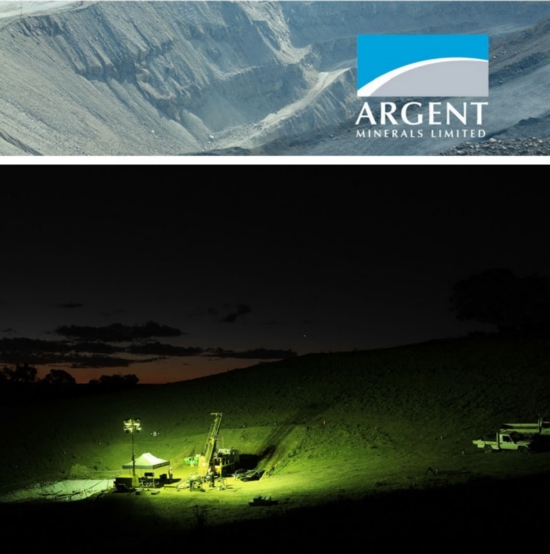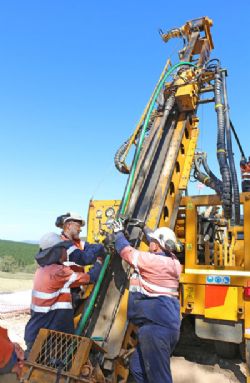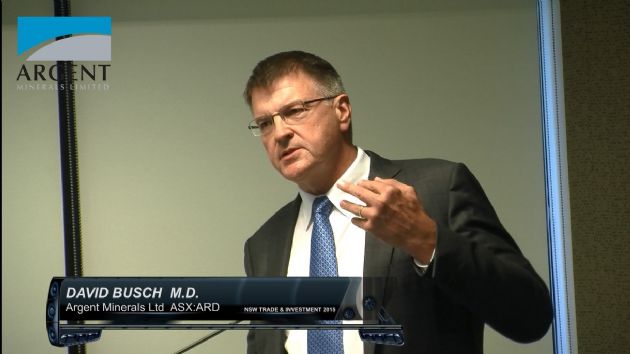 Hole 2 Increases Potential Size of the Prize at Kempfield
Hole 2 Increases Potential Size of the Prize at Kempfield
Sydney, April 21, 2015 AEST (ABN Newswire) - Argent Minerals Limited ( ASX:ARD) (Argent, Argent Minerals or the Company) is pleased to report exploration results for Hole #2 of the Kempfield deep diamond drilling program partly sponsored by NSW Trade & Investment, Resources & Energy Division.
ASX:ARD) (Argent, Argent Minerals or the Company) is pleased to report exploration results for Hole #2 of the Kempfield deep diamond drilling program partly sponsored by NSW Trade & Investment, Resources & Energy Division.
Managing Director David Busch said, "Hole #2 intersected 2 m @ 0.28g/t Au from 398 m, and 1 m @ 0.54g/t Au from 522 m, and strong hydrothermal alteration that occurred at relatively high temperatures.
"Together with the significant grade of gold intersected by Hole 1 - 5 m at 4 g/t Au from 353 m, the attributes of the material intersected by both Holes #1 and #2 are consistent with proximity to a high temperature Volcanogenic Massive Sulphide (VMS) feeder zone and the potential for high grade base and precious metal mineralisation featuring zinc and lead.
"A potentially major achievement of this early part of the drilling program is that examination and interpretation of the drill core has validated Argent's hypothesis for the formation processes and the model for the current structure of the Kempfield deposit.
"A significant outcome of this model validation is the increased potential 'size of the prize' at Kempfield. Now that earlier alternative models for the deposit have essentially been ruled out by the latest evidence, the validated model implies that the lengths of the steeply dipping lenses could extend to substantial depths from their uppermost portions at or near the surface. This applies to both the existing known lenses and the additional lenses targeted by Argent's continuing Kempfield deep diamond drilling program.
"Holes #3 and #4 will be drilled to test interpreted new Lens 4, and the strike extension of Lens 3. Hole #4 will mark the commencement of testing for lens extensions at depth beneath the existing deposit, firstly testing underneath Lens 3 where significant grades of up to 17.9% combined lead/zinc were previously intersected. "Additional hole design work is underway for the next phase of the Kempfield deep diamond drilling program, which will test the lens extensions at depth predicted by the validated deposit model".
About the potential proximity to adjacent high grade base and precious metal mineralisation
Under the hypothesis developed for Kempfield by Dr. Vladimir David in conjunction with Professor Ross Large of the Australian Research Council Centre for Excellence in Ore Deposits (CODES), the existing known Kempfield deposit is the predominantly silver/barite portion of a much larger VMS system in which higher grade base and precious metals remain to be discovered.
Under the favoured deposit model for the hypothesis, progressively higher base metal grades could be anticipated toward the West from the existing deposit in the East, correlating with zones of increasing temperature at the original time of deposition.
Furthest to the West, at the highest deposition temperatures associated with a VMS feeder source, the model predicts high grade gold, such as that intersected by Hole #1.
Holes #1 and #2 of the Kempfield diamond drilling program intersected strongly silicified and chlorite-altered host rock, quartz/pyrite/pyrrhotite and pyrite/pyrrhotite stockwork, indicative of high temperature deposition processes. Together with the significant grade of gold intersected by Hole #1 - 5 m at 4 g/t Au from 353 m, this early part of the Kempfield deep diamond drilling program has confirmed the existence of the high temperature portion of a VMS deposit spectrum associated with a VMS feeder zone.
These results imply the increased likelihood of a high grade lead/zinc zone somewhere between the Hole #1 gold intersection, and the western portion of the known deposit, as shown in Figure 1 in link below.
Given the indicated proximity to a feeder zone, it is possible for high grade lead/zinc mineralisation to also be located above or below Holes #1 #2 trajectories, or to their north or south.
About the model validation and the increased potential 'size of the prize' at Kempfield
A major achievement of this early part of the drilling program is that examination and interpretation of the drill core has validated Argent's hypothesis for the formation processes and the model for the current structure of the Kempfield deposit.
The stratigraphic sequence intersected by Holes #1 and #2 (see Appendix A summary) validates Argent's hypothesis for the formation and current structure of the Kempfield deposit, that it was most likely formed initially as a mound type VMS deposit, resembling a pancake-like stack of horizontal mineralised layers usually referred to as 'lenses'.
Subsequent to the initial lens deposition process, the entire mound was tilted and overturned by tectonic plate forces, to where the deposit rests today as a group of parallel mineralised lenses that are steeply dipping to the west (see Figure 2 in link below).
With earlier alternative models for the deposit effectively being ruled out by the latest evidence, the validated model implies that the lengths of the steeply dipping lenses could extend to substantial depths from their uppermost portions at or near the surface. This applies to both the existing known lenses and the additional lenses targeted by Argent's continuing Kempfield deep diamond drilling program.
To put this in perspective, the existing 21.8 Mt Mineral Resource1 has been estimated from the results of mostly shallow drilling conducted to a depth of only 120 metres, and highly concentrated on the areas of Lenses 1 and 2, and the southern portion of interpreted Lens 3.
Whilst this highly focused drilling resulted in a Mineral Resource with 82% of the estimated tonnes in Measured or Indicated category in potential readiness for advancement toward production, the vast majority of the Kempfield area remains untested for several hundred metres immediately to the west of the existing deposit, and at depth underneath the deposit.
The Company is also yet to test the extensive strike potential of up to 4 km to the north of the known deposit, which features geophysics anomalies that indicate further potential for mineralisation in that direction.
This validation of Argent's geological model for Kempfield represents a major step forward in understanding the structure of the deposit, which will be key to narrowing down the potential locations of the high grade base and precious metal mineralisation that the Company is targeting with its highly methodical approach to exploration.
NEXT STEPS
Downhole geophysics
Downhole electromagnetic (DHEM) surveys will be conducted for Holes #1 and #2 to assist in diamond hole design planning.
Holes 1 and 2 have been successfully cased to 480 and 702 metres respectively in preparation for the surveys, which will provide a significant volume of coverage in this portion of the exploration site given an approximate 200 metre radius of coverage by the DHEM sensor.
DHEM surveys are also planned to follow the drilling of Holes #3 and #4.
Holes #3 and #4 will be drilled to test interpreted new Lens 4, and the strike extension of Lens 3. Hole #4 will mark the commencement of testing for lens extensions at depth beneath the existing deposit, firstly testing underneath Lens 3 where significant grades of up to 17.9% combined lead/zinc were previously intersected.
Kempfield deep diamond drilling program - design of next phase of drilling underway Additional hole design work is underway for the next phase of the Kempfield deep diamond drilling program, which will test the lens extensions at depth predicted by the validated deposit model.
Details of the next drilling phase are expected to be announced shortly, on completion of the preliminary design.
To view figures, please visit:
http://media.abnnewswire.net/media/en/docs/ASX-ARD-716349.pdf
About Argent Minerals Limited
 Argent Minerals Limited (
Argent Minerals Limited ( ASX:ARD) is an Australian publicly listed company with a 100% interest in a silver/gold project at Kempfield NSW. Work is underway on the preparation of an EIS and a feasibility study for the first stage of the project which will involve heap leaching some 8.8 million tonnes of mainly oxide and transitional material to produce over 9.5 million ounces of silver and 15,000 ounces of gold over a 5 year mine life. Argent is also earning up to a 70% interest in two other NSW projects - gold at West Wyalong and base metals at Sunny Corner.
ASX:ARD) is an Australian publicly listed company with a 100% interest in a silver/gold project at Kempfield NSW. Work is underway on the preparation of an EIS and a feasibility study for the first stage of the project which will involve heap leaching some 8.8 million tonnes of mainly oxide and transitional material to produce over 9.5 million ounces of silver and 15,000 ounces of gold over a 5 year mine life. Argent is also earning up to a 70% interest in two other NSW projects - gold at West Wyalong and base metals at Sunny Corner.
![abnnewswire.com]()
Related Companies
Social Media
Share this Article

 ASX:ARD) (Argent, Argent Minerals or the Company) is pleased to report exploration results for Hole #2 of the Kempfield deep diamond drilling program partly sponsored by NSW Trade & Investment, Resources & Energy Division.
ASX:ARD) (Argent, Argent Minerals or the Company) is pleased to report exploration results for Hole #2 of the Kempfield deep diamond drilling program partly sponsored by NSW Trade & Investment, Resources & Energy Division.  Argent Minerals Limited (
Argent Minerals Limited ( ASX:ARD) is an Australian publicly listed company with a 100% interest in a silver/gold project at Kempfield NSW. Work is underway on the preparation of an EIS and a feasibility study for the first stage of the project which will involve heap leaching some 8.8 million tonnes of mainly oxide and transitional material to produce over 9.5 million ounces of silver and 15,000 ounces of gold over a 5 year mine life. Argent is also earning up to a 70% interest in two other NSW projects - gold at West Wyalong and base metals at Sunny Corner.
ASX:ARD) is an Australian publicly listed company with a 100% interest in a silver/gold project at Kempfield NSW. Work is underway on the preparation of an EIS and a feasibility study for the first stage of the project which will involve heap leaching some 8.8 million tonnes of mainly oxide and transitional material to produce over 9.5 million ounces of silver and 15,000 ounces of gold over a 5 year mine life. Argent is also earning up to a 70% interest in two other NSW projects - gold at West Wyalong and base metals at Sunny Corner.






